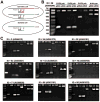Silencing of germline-expressed genes by DNA elimination in somatic cells
- PMID: 23123092
- PMCID: PMC3620533
- DOI: 10.1016/j.devcel.2012.09.020
Silencing of germline-expressed genes by DNA elimination in somatic cells
Abstract
Chromatin diminution is the programmed elimination of specific DNA sequences during development. It occurs in diverse species, but the function(s) of diminution and the specificity of sequence loss remain largely unknown. Diminution in the nematode Ascaris suum occurs during early embryonic cleavages and leads to the loss of germline genome sequences and the formation of a distinct genome in somatic cells. We found that ∼43 Mb (∼13%) of genome sequence is eliminated in A. suum somatic cells, including ∼12.7 Mb of unique sequence. The eliminated sequences and location of the DNA breaks are the same in all somatic lineages from a single individual and between different individuals. At least 685 genes are eliminated. These genes are preferentially expressed in the germline and during early embryogenesis. We propose that diminution is a mechanism of germline gene regulation that specifically removes a large number of genes involved in gametogenesis and early embryogenesis.
Copyright © 2012 Elsevier Inc. All rights reserved.
Figures





Comment in
-
Silencing by throwing away: a role for chromatin diminution.Dev Cell. 2012 Nov 13;23(5):918-9. doi: 10.1016/j.devcel.2012.10.022. Dev Cell. 2012. PMID: 23153488
References
-
- Bachmann-Waldmann C, Jentsch S, Tobler H, Muller F. Chromatin diminution leads to rapid evolutionary changes in the organization of the germ line genomes of the parasitic nematodes A. suum and P. univalens. Mol Biochem Parasitol. 2004;134:53–64. - PubMed
-
- Boveri T. Ueber Differenzierung der Zellkerne wahrend der Furchung des Eies von Ascaris megalocephala. Anat Anz. 1887;2:688–693.
-
- Boveri T. Festschr fur C von Kupffer. Jena: Fisher; 1899. Die Entwicklung von Ascaris megalocephala mit besonderer Rucksicht auf die Kernverhaltnisse; pp. 383–430.
Publication types
MeSH terms
Substances
Associated data
- Actions
Grants and funding
LinkOut - more resources
Full Text Sources
Other Literature Sources
Molecular Biology Databases
Miscellaneous

